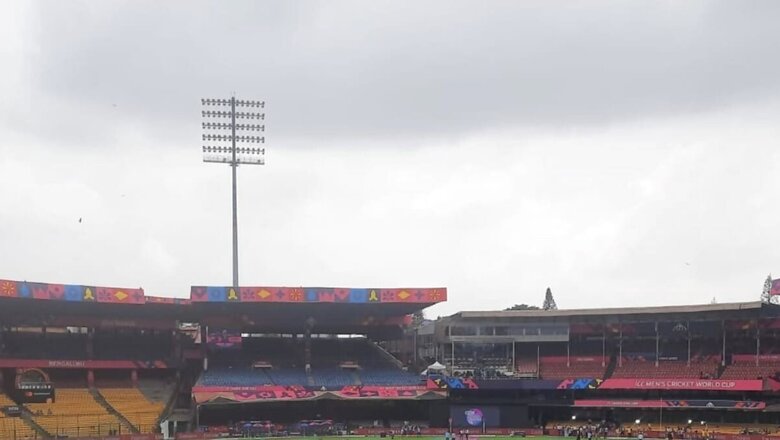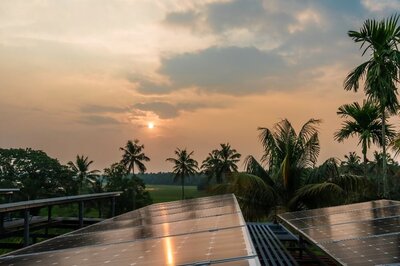
views
The final league fixtures of the 2023 ICC ODI World Cup are about to begin, with New Zealand facing Sri Lanka in a must-win match at Bengaluru’s M. Chinnaswamy Stadium on Thursday.
Rain has been predicted for the match, which could prove decisive for the Blackcaps qualifying for the final four stages of the tournament. But they have one piece of technology which could ensure they make it to the semifinals.
LIVE: New Zealand vs Sri Lanka ICC Cricket World Cup 2023
How the Chinnaswamy Stadium installed the Sub-Air system
The year 2024 will be special for the Karnataka State Cricket Association (KSCA) as in November, it will be 50 years since Bengaluru’s M. Chinnaswamy Stadium first hosted an international game between India and West Indies.
The game was also the debut for two future greats of international cricket- Gordon Greenidge and Sir Vivian Richards and for the administrators present at the time, it must have proud moment to have played a role in the smooth conduct of the game.
If the previous generation of administrators could hold their heads high to ensure regular high-quality cricket came to the venue, the present generation can be proud of a feature to the ground that is unlike any other in India.
41 years after first hosting a Test match, India played South Africa in a five-day affair at the venue in November 2015. It was AB de Villiers’ 100th Test match for the Proteas and many hoped for a cracking contest to mark the occasion.
But it wasn’t to be as rain arrived at the venue late on the opening day of the game. Persistent rain on the second day washed out play without a ball being bowled.
A steady drizzle did not let any play happen on the third day. On the fourth day of the Test, rain had completely stopped but the outfield had taken such a beating in the previous three days that it had left behind giant puddles which prevented any play.
On the fifth and final day of the match, a drizzle that refused to leave meant that no play was possible and the match ended in a draw with just a single day of play possible.
It was embarrassing for a venue that had hosted some fantastic matches for several years. The KSCA, it seemed like, had seen enough. Between June 2016, after the conclusion of the Indian Premier League, and January 2017, the association let other state centres such as Mysuru and Belagavi host domestic matches and dug up the Chinnaswamy to install the drainage system. Six years later, it is still praised by many for its efficiency.
The SubAir system’s installation at the stadium was to ensure quicker drying of the outfield once the rain stopped and swifter restart of the match.
How the SubAir system works
The system runs a 200-horsepower machine, developed by a US-based company called SubAir. The system works in two modes- pressure mode and suction mode.
The latter is vacuum-powered and is deployed to remove the water out of the outfield. The SubAir system can remove a maximum of 10,000 litres of water per minute.
The crucial feature to the SubAir system is that it begins to draw the water when it starts raining at the venue, which speeds up the drying process and also ensures there are reduced chances of puddle formation on the outfield.
The pressure mode of the SubAir system helps provide fresh air to the grassroots and is the system’s default mode.
At the time of installation, remote sensors were embedded in different parts of the Chinnaswamy stadium outfield to help detect the amount of water that had fallen on the ground. Once the water goes above the normal level, the sensors send a signal to the machine, which then automatically switches to suction mode.
However, the system’s installation did not mean that the water would be flushed out and play could begin immediately after a rain break. The administrators had to dig up the ground and replace the old red soil base prevalent since 1968 with a new sand base to ensure that the SubAir system worked efficiently.
“If you take regular soil and water, it will swell and become a lump, which does not happen with sand. The drainage system takes the water out, but in other kinds of soil, the surface moisture is retained. Sand, on the other hand, does not hold water.
“It allows water to percolate, which means the outfield is less slippery and injury risks are minimised. Sand is expensive, and you need to be very good with maintenance, especially in cool climates like Bangalore, where fungal infection is something to look out for,” P.R. Viswanathan, the BCCI’s South Zone curator told ESPN Cricinfo in 2017.
The SubAir system is operated digitally, with schedules set well in advance. The pressure mode of the system is activated every hour to offer aeration to the roots. The frequency can differ based on the weather conditions.
An aspect of the system that can prove useful during the World Cup is the system’s ability to control dew- an occurrence that is most likely to happen in the winter setting in Bengaluru.
The Chinnaswamy Stadium now boasts of a new drainage system, which will efficiently tackle the problem of rain delays. The Karnataka State Cricket Association (KSCA) unveiled a sub-surface aeration and vacuum-powered drainage system, built by SubAir Systems, at the stadium pic.twitter.com/u2lK8hW1t8— Shoibkhan (@Shoibkhan015) May 21, 2023
One of the more recent examples that showed the effectiveness of the SubAir system came on May 21 when Bengaluru witnessed heavy rain coupled with hailstorms in the afternoon and evening.
Follow all the action from the ICC Cricket World Cup 2023 including the World Cup schedule, World Cup 2023 results, and ICC Cricket World Cup points table. Players are vying to top the World Cup 2023 Most Runs and World Cup 2023 Most Wickets charts.
Yet, a must-win game for IPL side Royal Challengers Bangalore against the reigning champions Gujarat Titans began just under an hour after the scheduled start of play with no overs lost on a bone-dry outfield.
The SubAir system had done its job and had left many on social media scratching their heads. Many could not believe how a city that had been inundated by the rains had seen a cricket match stay unaffected by the heavy downpour.
Despite the torrential rains at Chinnaswamy Stadium, Bengaluru this afternoon, our SubAir (subsurface-aeration) System made sure the field was ready for play within minutes! pic.twitter.com/VkpXLY7jLd— Great SportsTech (@GreatSportsTech) May 21, 2023
The system’s effectiveness was such that it forced some users on social media to contemplate whether installing the system on Bengaluru roads might help solve the rain woes in the city.
The work done by the SubAir system also received praise from former BCCI Chief Administrative Officer Ratnakar Shetty who said that the Karnataka State Cricket Association had been ahead of its time by installing the system in 2017.
Millions of fans watched the last league game of IPL-23 and that too a full absorbing game.Let us put our hands together for KSCA for their vision to upgrade infrastructure at Chinnaswamy Stadium a decade ago. It was the sub air system that made the game possible.— Ratnakar Shetty (@RatnakarShetty6) May 22, 2023
The KSCA has emerged as a model organization for others due to its work, as much for the work the men and women have done away from the game as for the quality of cricket on view for the spectators.
But few would argue that in its 49 years of history, the SubAir system at the M. Chinnaswamy Stadium has emerged as the bonafide Unique Selling Point for the venue and in some ways, for Indian cricket as well.



















Comments
0 comment